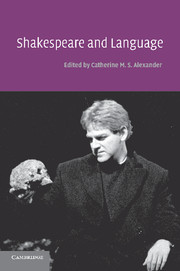Book contents
- Frontmatter
- Contents
- List of contributors
- Editor's note
- 1 Shakespeare and language: an introduction
- 2 Shakespeare's language and the language of Shakespeare's time
- 3 The foundations of Elizabethan language
- 4 Shakespeare's talking animals
- 5 Some functions of Shakespearian word-formation
- 6 Shakespeare and the tune of the time
- 7 Shakespeare's Romeo and Juliet: the places of invention
- 8 Shakespeare's thematic modes of speech: Richard II to Henry V
- 9 Hamlet and the power of words
- 10 The art of the comic duologue in three plays by Shakespeare
- 11 Hamlet's ear
- 12 ‘Voice potential’: language and symbolic capital in Othello
- 13 The aesthetics of mutilation in Titus Andronicus
- 14 ‘Time for such a word’: verbal echoing in Macbeth
- 15 Household words: Macbeth and the failure of spectacle
- 16 Late Shakespeare: style and the sexes
- Index
6 - Shakespeare and the tune of the time
Published online by Cambridge University Press: 15 December 2009
- Frontmatter
- Contents
- List of contributors
- Editor's note
- 1 Shakespeare and language: an introduction
- 2 Shakespeare's language and the language of Shakespeare's time
- 3 The foundations of Elizabethan language
- 4 Shakespeare's talking animals
- 5 Some functions of Shakespearian word-formation
- 6 Shakespeare and the tune of the time
- 7 Shakespeare's Romeo and Juliet: the places of invention
- 8 Shakespeare's thematic modes of speech: Richard II to Henry V
- 9 Hamlet and the power of words
- 10 The art of the comic duologue in three plays by Shakespeare
- 11 Hamlet's ear
- 12 ‘Voice potential’: language and symbolic capital in Othello
- 13 The aesthetics of mutilation in Titus Andronicus
- 14 ‘Time for such a word’: verbal echoing in Macbeth
- 15 Household words: Macbeth and the failure of spectacle
- 16 Late Shakespeare: style and the sexes
- Index
Summary
Linguistic changes do not occur overnight. At any point along the development of English, old and new usages coexist, sometimes as sheer alternatives, sometimes with overtones on the one side or on the other of obsolescence, up-to-dateness, formality or colloquialism fitting them to one register or variety of English rather than to another. Exploitation of the possibilities created by this situation in its late sixteenth and early seventeenth century form is an essential part of Shakespeare's dramatic and poetic technique, and to recognize that in a particular scene, speech or line, or in one character, he is making use of the shifting linguistic conditions of his time is to see more of his skill as a manipulator of language, as well as to understand better the particular incident involved.
In Romeo and Juliet for example, just before the Balcony scene, Mercutio has a longish speech in which he mocks Romeo's infatuation with Rosaline by calling after him:
Romeo, Humours, Madman, Passion, Louer,
Appeare thou in the likenesse of a sigh,
Speake but one rime, and I am satisfied:
Cry me but ay me, Pro[nounce] but Loue and d[oue],
Speake to my goship Venus one faire word,
One Nickname for her purblind Sonne and her,
Young Abraham Cupid he that shot so true,
When King Cophetua lou'd the begger Maid,
He heareth not, he stirreth not, he moueth not,
The Ape is dead, I must coniure him,
I coniure thee by Rosalines bright eyes,
By her High forehead, and her Scarlet lip,
By her Fine foote, Straight leg, and Quiuering thigh,
And the Demeanes, that there Adiacent lie,
That in thy likenesse thou appeare to vs.
(657a, 1–15; 2.1.7–21)- Type
- Chapter
- Information
- Shakespeare and Language , pp. 101 - 121Publisher: Cambridge University PressPrint publication year: 2004



